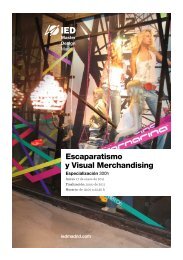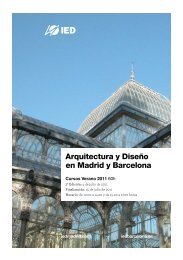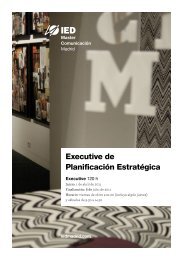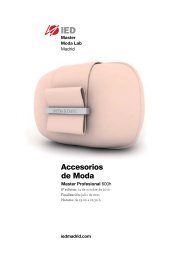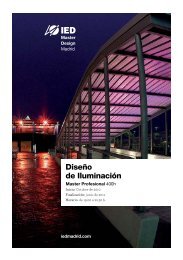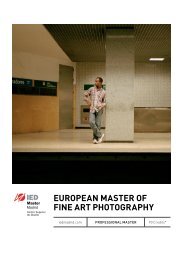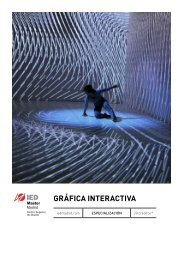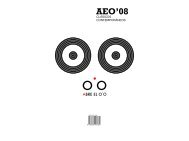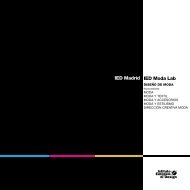nuevos valores del diseño new design values - IED Madrid
nuevos valores del diseño new design values - IED Madrid
nuevos valores del diseño new design values - IED Madrid
Create successful ePaper yourself
Turn your PDF publications into a flip-book with our unique Google optimized e-Paper software.
Eco<strong>diseño</strong><br />
Eco-<strong>design</strong><br />
A día de hoy son muchos los factores que hacen frágil nuestro<br />
modo de vida. Uno de ellos es la vulnerabilidad <strong>del</strong> medio<br />
ambiente ante el agresivo crecimiento demográfico mundial y<br />
la erosión que éste provoca sobre los diferentes escenarios <strong>del</strong><br />
planeta. Los gobiernos, las comunidades, la industria y, en definitiva,<br />
la sociedad, trabajan para impedir que la contaminación<br />
y el consumo deterioren aún más la Tierra y sus recursos,<br />
demandando urgentemente <strong>nuevos</strong> procesos industriales que<br />
proporcionen productos menos contaminantes y sostenibles.<br />
El uso indiscriminado de materiales no renovables y la dependencia<br />
<strong>del</strong> petróleo como fuente principal de energía resulta<br />
insostenible a medio-largo plazo. Por tanto, un cambio<br />
hacia unas bases más biológicas de producción, sistemas más<br />
respetuosos con la energía y los materiales y, finalmente, una<br />
reutilización de bioproductos, resulta fundamental para el desarrollo<br />
y progreso de generaciones futuras.<br />
Por otro lado, los usuarios reclaman cada vez más que se<br />
tengan en cuenta los aspectos medioambientales en el <strong>diseño</strong><br />
de los productos y los espacios.<br />
Esta nueva demanda es consecuencia de una mayor y creciente<br />
concienciación, competencia y presión empresarial,<br />
nuevas oportunidades de negocio, <strong>nuevos</strong> estándares como<br />
la ISO 14001, además de una nueva y exigente legislación al<br />
respecto, que se ocupa de los materiales y la energía.<br />
Como parte de las alternativas que han surgido para ralentizar<br />
y controlar este peligroso crecimiento, está el eco<strong>diseño</strong>.<br />
Una fusión entre la actividad creadora, propia de la naturaleza<br />
humana, y una conciencia nueva, capaz de redefinir ciertos<br />
procesos y aplicaciones erróneos a la hora de proyectar y explotar<br />
un producto, en donde intervienen las tres partes que<br />
definen la vida de éste: diseñadores, productores y usuarios.<br />
Sin embargo, en términos medioambientales la consideración<br />
<strong>del</strong> eco<strong>diseño</strong> como nueva disciplina está aún en una etapa<br />
muy preliminar.<br />
El eco<strong>diseño</strong> puede definirse como las “93 acciones orientadas<br />
a la mejora ambiental <strong>del</strong> producto en la etapa inicial<br />
de <strong>diseño</strong>, mediante la mejora de la función, selección de<br />
materiales menos impactantes, aplicación de procesos alternativos,<br />
mejora en el transporte y en el uso, y minimización<br />
de los impactos en la etapa final de tratamiento” (Dr. Joan<br />
Rieradevall).<br />
El nuevo enfoque de la política ambiental europea (Política<br />
Integrada de Productos IPP), requiere que aquellos profesionales<br />
de los campos <strong>del</strong> <strong>diseño</strong>, la ingeniería y el medio<br />
ambiente que deben tomar decisiones sobre productos y<br />
procesos, incorporen criterios ambientales. La carencia de<br />
profesionales expertos en la prevención y mejora ambiental<br />
en el proceso de elaboración de <strong>nuevos</strong> productos, junto con<br />
la creciente demanda de los consumidores de productos más<br />
respetuosos con el medio ambiente, y el incremento de la<br />
sostenibilidad por parte de las administraciones públicas, así<br />
como la presión de las empresas hacia sus proveedores para<br />
que desarrollen mejoras ambientales asociadas a sus productos,<br />
son algunos de los elementos que hemos tenido en cuenta<br />
a la hora de plantear este proyecto de tesis.<br />
Serán objetivos <strong>del</strong> mismo la concienciación y asimilación<br />
de una nueva visión más global de los problemas ambientales<br />
asociados a los productos y a su fabricación, facilitando herramientas<br />
de prevención y mejora ambiental.<br />
Victoria de Pereda<br />
Directora de Design <strong>IED</strong> <strong>Madrid</strong><br />
At the moment, there are many factors which contribute<br />
to the precariousness of our way of life. One of them is the<br />
vulnerability of the environment to the aggressive increase<br />
in global population, and the subsequent erosion that this<br />
causes in different parts of the world. Governments, communities,<br />
industry and, in short, society, are working to prevent<br />
pollution and consumerism from causing further damage to<br />
the Earth and its resources, by urgently demanding <strong>new</strong> industrial<br />
processes which provide more sustainable, and less<br />
polluting, products.<br />
The indiscriminate use of non-re<strong>new</strong>able materials and our<br />
dependence on oil as our main energy source is untenable in<br />
the medium-long term. Therefore, it is essential for the development<br />
and progress of future generations that we adopt<br />
more biological bases of production, as well as systems which<br />
are more energy-efficient and respectful in their use of materials,<br />
and, lastly, the reutilization of bio-products.<br />
On the other hand, users are increasingly demanding that<br />
environmental issues are taken into account in the <strong>design</strong> of<br />
products and spaces.<br />
This <strong>new</strong> demand is the result of increasing awareness,<br />
competition and pressure in the business sector, <strong>new</strong> business<br />
opportunities, <strong>new</strong> standards, such as ISO 14001, as well as a<br />
<strong>new</strong> and exacting legislation in this area, which is concerned<br />
with materials and energy.<br />
Eco-<strong>design</strong> forms part of the alternatives which have<br />
emerged to control and slow down this dangerous growth. It<br />
is a combination of creative activity, typical of human nature,<br />
and a <strong>new</strong> awareness, which is able to redefine certain erroneous<br />
processes and applications in the <strong>design</strong> and marketing of<br />
a product, where the three elements which define its life are<br />
involved: <strong>design</strong>ers, producers and users. However, in environmental<br />
terms, our awareness of eco-<strong>design</strong> as a <strong>new</strong> discipline<br />
is still at a very early stage.<br />
Eco-<strong>design</strong> can be described as “93 actions aimed at the<br />
environmental improvement of a product at the early <strong>design</strong><br />
stage, through the improvement of its function, the selection<br />
of materials which have less environmental impact, the application<br />
of alternative processes, improvements in transport<br />
and use, and the minimisation of environmental impact at the<br />
final treatment stage” (Dr Joan Rieradevall).<br />
The <strong>new</strong> approach of European environmental policy (Integrated<br />
Product Policy, or IPP), requires that professionals working<br />
in the fields of <strong>design</strong>, engineering and the environment who<br />
must make decisions regarding products and processes, incorporate<br />
environmental criteria. The lack of professionals specialising<br />
in damage prevention and environmental improvements in<br />
the process of producing <strong>new</strong> products, together with the growing<br />
demand on the part of consumers for products which are<br />
more respectful of the environment, and increased sustainability<br />
on the part of the public administrations, as well as the pressure<br />
exerted by companies on their suppliers to develop environmental<br />
improvements associated with their products, are some of<br />
the elements we have taken into account in our approach to the<br />
planning of this thesis.<br />
This thesis will have as its objectives the increase in awareness<br />
and assimilation of a <strong>new</strong>, more global, view of the environmental<br />
problems linked to products and their manufacturing,<br />
and will provide tools for the prevention of environmental<br />
damage and for environmental improvements.<br />
Victoria de Pereda<br />
Design Director, <strong>IED</strong> <strong>Madrid</strong><br />
14 15




